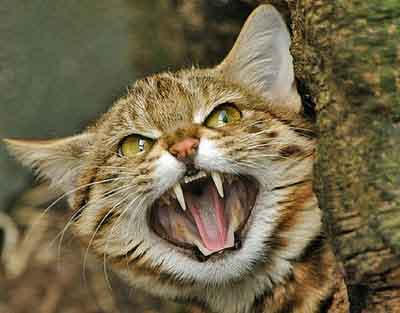The cat (wild or domestic) considered to be the best hunter is probably the black-footed cat. They are outstandingly active and successful hunters. They make one hunting attempt every 30 minutes and kill a bird or a mammal every 50 minutes. One male cat was recorded as catching 12 rodents in 3 1/2 hours. This species puts domestic cats to shame when it comes to hunting (and they look like small domestic tabby cats).

Where?
This diminutive wild cat lives in three countries in Africa: Botswana, Namibia and South Africa. It is restricted to an area which is more arid than normal. It is the smallest of the African cats. An adult black-footed cat weighs about 2 kg. This is roughly the same as the smallest cat species in Asia and South America. 2 kg equates to 4 1/2 pounds which is about half the size of a moderately sized domestic cat.
Phenomenal aggression and success
This cat lives in an open landscape but is still remarkably successful when hunting. The species is considered to be the deadliest cat on earth according to livescience.com. In one night a single individual can kill between 10 and 14 rodents or small birds. This averages a kill every 50 minutes. The success rate is 60%. This makes them three times as successful as lions which have an average success rate of 20 to 25%.
Dry habitat
The black footed cat lives in dry, open habitats with some vegetation for cover. They obtain all the moisture they need from their prey and live in areas where there is no water. They will drink water if it’s available.
Hunting techniques
The black-footed cat is very secretive and evasive. They are also strictly nocturnal. They have three hunting techniques one of which is called “fast hunting”. The cat moves forward quickly and apparently randomly through tall grass which flushes out small prey such as rodents and birds.
A slower technique has the cat moving through their habitat while weaving quietly and carefully when approaching potential prey. The third technique is to sit, watch and wait near rodents’ burrows. This technique is called “still hunting”. The cat can remain immobile for up to 2 hours waiting patiently for a rodent to appear.
Prey types
Three quarters of the prey captured by black-footed cat are gerbils, mice and shrews. These mammals represent almost 40% of the total weight of prey consumed. 21% of prey captured consist of small birds such as larks, pipits, chats and wheatears. They also eat insects and consume a large number but by weight this prey amounts to only 2% of prey eaten. More than half of the total weight of prey consumed consists of creatures weighing less than 30 to 40 g.
Scavenge
They sometimes scavenge Springbok lambs and have been known to kill Cape hares as well as black bustards. When feeding on a bustard this cat gorges itself like a tiger eating as much as 20 to 30% of its own bodyweight in a night. The cat will still go on hunting efficiently in between eating.
The black-footed cat uses a nape bite to kill prey. They don’t normally pluck the feathers from birds before eating. They do, however, pluck some feathers from the wings and body of larger birds such as the button quail.
The killing bite
I’ll quote directly from Wild Cats of the World with respect to killing birds:
“They slide themselves over the prey from the rear, lay the forepaws on either side of the animal, and using the dewclaws, hold the prey firmly against the ground. While the wriggling animal is held tightly in this position, the cat pulls its head back and waits for the right moment to deliver the killing next bite”.

